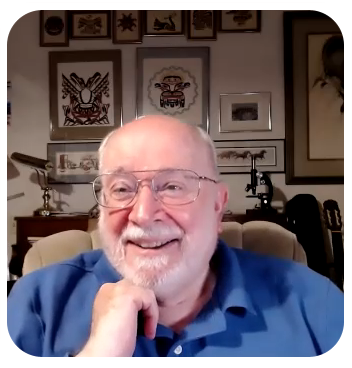Chester L. Richards
Aerospace Engineer (Ret.), Inventor, Adventurer, Author, Storyteller, Romantic
The philosophy developed by Chester L. Richards, aerospace engineer, adventurer and inventor (19 patents), has indeed caused him to view all that comes his way as an adventure. Even a visit to the hospital! (Look for stories about these surprisingly entertaining forays into Deep Space Medical soon in his blog, "Stories.")
That attitude took shape early. In college, a bit after those early escapes from being thoroughly roasted by The Great Potato's molten lead flinging tricks, Chester and friend Judy Burns co-authored a spec script for “Star Trek” on a lark. The story, “The Tholian Web,” became one of the series’ most popular episodes. A veteran writer advised the young man, “You should write….write your passions.” “But I have nothing to say,” Chester thought. That was the moment he decided the real message was to fill his life with adventures. And he did — adventures in surfing, learning and performing music, travel to exotic places for river rafting, and his work as a rocket scientist. Along the way, he’s always met fascinating characters. He did write — essays (over 50 have been published so far). At the house in Thousand Oaks he and his late beloved Sarah once shared, he brought himself back from the brink of despair by writing the hair-raising adventures Sarah loved, and that continue to occur, though as the author says, he no longer has much hair.
That attitude took shape early. In college, a bit after those early escapes from being thoroughly roasted by The Great Potato's molten lead flinging tricks, Chester and friend Judy Burns co-authored a spec script for “Star Trek” on a lark. The story, “The Tholian Web,” became one of the series’ most popular episodes. A veteran writer advised the young man, “You should write….write your passions.” “But I have nothing to say,” Chester thought. That was the moment he decided the real message was to fill his life with adventures. And he did — adventures in surfing, learning and performing music, travel to exotic places for river rafting, and his work as a rocket scientist. Along the way, he’s always met fascinating characters. He did write — essays (over 50 have been published so far). At the house in Thousand Oaks he and his late beloved Sarah once shared, he brought himself back from the brink of despair by writing the hair-raising adventures Sarah loved, and that continue to occur, though as the author says, he no longer has much hair.
The nitty gritty : Highlights of Chester's SCIENTIFIC WORK, education, and personal pursuits
Prior to retirement, Chester L. Richards was an Engineering Fellow at Raytheon Space and Airborne Systems Division. At Raytheon he was Chief Architect for Advanced Concepts and Architectures. Before joining Raytheon Mr. Richards had an engineering consulting business. His diverse technology career spans half a century.
At the beginning of his professional life as a scientist, Mr. Richards invented and patented the first successful automatic focus sensor using real-time image analysis. It was used in aerial reconnaissance cameras.
Subsequently, while at the Ford Aerospace Corporation, Mr. Richards was Chief Engineer for Strategic Systems. At Ford he developed the flight instrumentation for the AGNT space flight and re-entry experiment. Mr. Richards invented and patented the Holographic Optical Element which is widely used in large aperture adaptive optics telescopes. Mr. Richards also invented, and successfully field tested, sub-resolution tracking techniques which improved tracking accuracy by two orders of magnitude.
During part of his career Chester L. Richards served as a System Engineering Technical Assistant (SETA) consultant to the U.S. Government. In this role Mr. Richards developed the modern Space Based Laser architecture for the Strategic Defense Initiative Organization. He was a member of SDIO’s Mission Analysis Working Group and its Innovative Science and Technology group. As SETA he helped define the functional architecture of Schriever Space Force Base and wrote the Statement of Work establishing the requirements for the base.
For the Air Force, Chester L. Richards created the definitive high fidelity sensor model for the DSP satellite series. In addition, he developed high precision target tracking techniques for the Hover Test Facility at Edwards Air Force Base.
At Raytheon one of his most important discoveries was the complete quantitative theory of bistatic radar, which previously had been only partially understood. This led to multiple fielded applications.
The technical interests of Mr. Richards include system architecture, space systems, physical optics, high energy lasers, image processing, radar, ergonomics, and jet and rocket propulsion.
Other activities include: Co-author of “The Tholian Web” script for the third season of the original Star Trek series.
Chester L. Richards has a Bachelor’s Degree in Physics from UC Berkeley and a Masters in Physics from UC Irvine. He completed all course work for PhDs in both Physics and Engineering at UC Irvine. Mr. Richards has 19 patents. His latest patent is for a centrifugal gas generator for gas turbine engines.
KEY PLAYERS IN CHESTER'S LIFE AND BOOK
Rocket Science
"Taking part in exploring the mysteries of Space, what it takes to get rockets to the moon, and all the extraordinary people I've been lucky to have met, worked with, and with whom I've become great friends has been a great gift."
|









